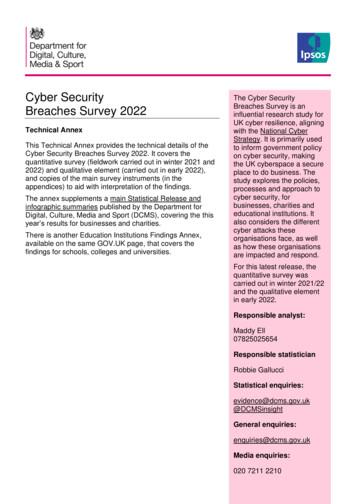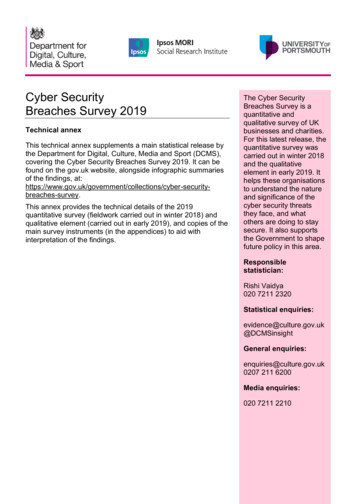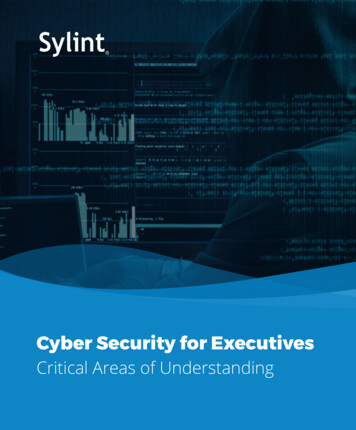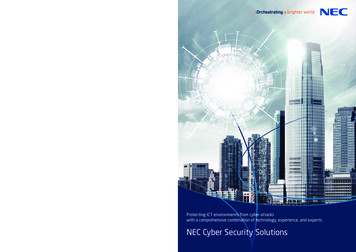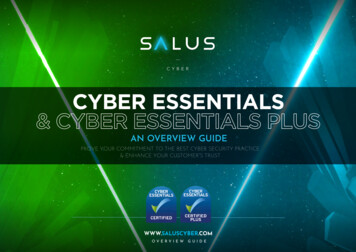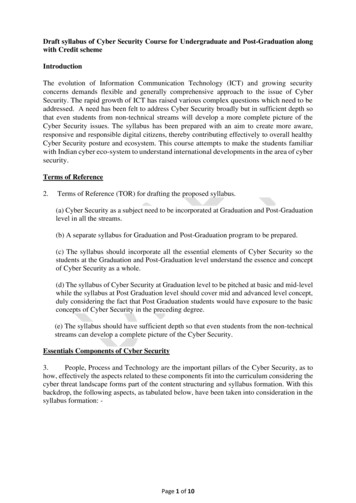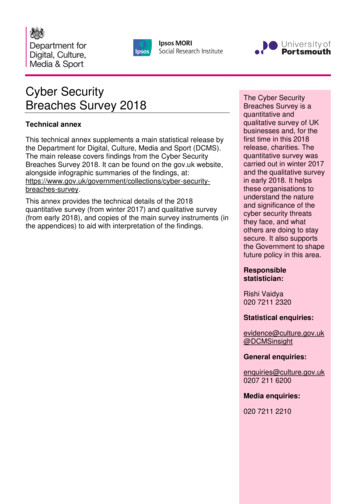
Transcription
Cyber SecurityBreaches Survey 2018Technical annexThis technical annex supplements a main statistical release bythe Department for Digital, Culture, Media and Sport (DCMS).The main release covers findings from the Cyber SecurityBreaches Survey 2018. It can be found on the gov.uk website,alongside infographic summaries of the findings, -securitybreaches-survey.This annex provides the technical details of the 2018quantitative survey (from winter 2017) and qualitative survey(from early 2018), and copies of the main survey instruments (inthe appendices) to aid with interpretation of the findings.The Cyber SecurityBreaches Survey is aquantitative andqualitative survey of UKbusinesses and, for thefirst time in this 2018release, charities. Thequantitative survey wascarried out in winter 2017and the qualitative surveyin early 2018. It helpsthese organisations tounderstand the natureand significance of thecyber security threatsthey face, and whatothers are doing to staysecure. It also supportsthe Government to shapefuture policy in this area.Responsiblestatistician:Rishi Vaidya020 7211 2320Statistical al enquiries:enquiries@culture.gov.uk0207 211 6200Media enquiries:020 7211 2210
Department for Digital, Culture, Media and SportCyber Security Breaches Survey 2018: Technical AnnexContentsChapter 1:Overview . 11.1 Summary of methodology . 11.2 Strengths and limitations of the 2018 survey . 11.3 Changes from previous waves . 21.4 Comparability to the earlier Information Security Breaches Surveys . 2Chapter 2: Survey approach technical details . 32.1 Survey and questionnaire development. 32.2 Survey microsite . 52.3 Sampling. 52.4 Fieldwork . 82.5 Fieldwork outcomes and response rate . 102.6 Data processing and weighting . 12Chapter 3: Qualitative approach technical details. 163.1 Sampling. 163.2 Recruitment and quotas. 163.3 Fieldwork . 163.4 Analysis . 18Appendix A: Pre-interview questions sheet . 19Appendix B: Interviewer glossary . 20Appendix C: Questionnaire . 22Appendix D: Topic guide . 57Appendix E: Further information . 64
Department for Digital, Culture, Media and SportCyber Security Breaches Survey 2018: Technical Annex1Chapter 1: Overview1.1 Summary of methodologyThere were two strands to the survey: A quantitative random probability telephone survey of 1,519 UK businesses and 569 UKregistered charities was undertaken from 9 October 2017 to 14 December 2017. A qualitative survey consisting of 50 in-depth interviews were undertaken in January andFebruary 2018 to follow up with businesses and charities that had participated in thesurvey, as well as higher education institutions.1.2 Strengths and limitations of the 2018 surveyWhile there have been other surveys about cyber security in organisations in recent years,these have often used partially representative sampling or data collection methods. By contrast,the Cyber Security Breaches Survey series is intended to be statistically representative of UKbusinesses of all sizes and all relevant sectors, and UK registered charities in all income bands.The 2018 survey shares the same strengths as the 2016 and 2017 surveys: the use of random-probability sampling to avoid selection bias the inclusion of micro and small businesses, and low-income charities, which ensures thatthe respective findings are not skewed towards larger organisations a telephone data collection approach, which aims to also include businesses and charitieswith less of an online presence (compared to online surveys) a comprehensive attempt to obtain accurate spending and cost data from respondents, byusing a pre-interview questions sheet and microsite, and giving respondents flexibility inhow they can answer (e.g. allowing numeric and banded amounts, as well as answersgiven as percentages of turnover or IT spending) a consideration of the cost of cyber security breaches beyond the immediate time-cost(e.g. explicitly asking respondents to take into account their direct costs, recovery costsand long-term costs, while giving a description of what might be included within each ofthese costs).At the same time, while this survey aims to produce the most representative, accurate andreliable data possible with the resources available, it should be acknowledged that there areinevitable limitations of the data, as with any survey project. Two main limitations might beconsidered to be as follows: Organisations can only tell us about the cyber security breaches or attacks that they havedetected. There may be other, breaches or attacks affecting organisations, but which arenot identified as such by their systems or by staff. Therefore, the survey may have atendency to systematically underestimate the real level of breaches or attacks. When it comes to estimates of spending and costs associated with cyber security, thissurvey still ultimately depends on self-reported figures from organisations. As previousyears’ findings suggest, most organisations do not actively monitor the financial cost ofcyber security breaches. Moreover, as above organisations cannot tell us about the cost ofany undetected breaches or attacks. Again, this implies that respondents mayunderestimate the total cost of all breaches or attacks (including undetected ones).
Department for Digital, Culture, Media and SportCyber Security Breaches Survey 2018: Technical Annex2 The qualitative in-depth interviews did not feature any examples of the kinds of substantivecyber security breaches that have featured in news and media coverage of the topic. It istherefore outside the scope of this survey to provide significant insights into how thelargest UK businesses and charities deal with these especially substantive breaches,which may cost in the range of hundreds of thousands, or even millions of pounds.1.3 Changes from previous wavesOne of the objectives of the survey is to understand how approaches to cyber security and thecost of breaches are evolving over time. Therefore, the survey methodology is intended to be ascomparable as possible to the 2016 and 2017 surveys. There were important changes in thescope of the survey in 2018, although these do not typically affect comparability: For the first time in this survey series, UK registered charities were included. Previoussurveys only covered UK businesses. The quantitative survey findings for both groupshave been reported separately, rather than as a merged sample of all UK organisations.This is because there is no population profile information for UK businesses and charitiescombined. The quantitative survey business sample has also been expanded to include mining andquarrying businesses (SIC sector B) for the first time. As of April 2018, this sector isestimated to account for under 0.1 per cent of all UK businesses, so the addition of thissector has not meaningfully impacted on the comparability of findings across years. A small number of questions from the 2016 and 2017 quantitative surveys were deleted in2018 to make way for new questions. Section 2.1 summarises these changes. In the mainreport, comparisons to 2016 and 2017 findings are only made where valid (i.e. wherequestions were consistent). The qualitative survey specifically included three interviews with higher educationinstitutions (including two universities). This was highlighted as an important subsector forDCMS and the National Cyber Security Centre. These interviews, as with the widerqualitative survey, are not intended to be representative but have given DCMS and itspartners some specific insights about this subsector.1.4 Comparability to the earlier Information Security Breaches SurveysFrom 2012 to 2015, the Government commissioned and published annual Information SecurityBreaches Surveys. While these surveys covered similar topics to the Cyber Security BreachesSurvey series, they employed a radically different methodology, with a self-selecting onlinesample weighted more towards large businesses. Moreover, the question wording and order isdifferent for both sets of surveys. This means that comparisons between surveys from bothseries are not possible.
Department for Digital, Culture, Media and SportCyber Security Breaches Survey 2018: Technical Annex3Chapter 2: Survey approach technical details2.1 Survey and questionnaire developmentThe questionnaire and all other survey instruments were developed by Ipsos MORI and theInstitute for Criminal Justice Studies (ICJS), and approved by DCMS. Development for thisyear’s survey took place over three stages from July to September 2017: stakeholder conversations (mainly by email) involving Government, three general businessrepresentative bodies, five trade associations, seven IT or security representative bodies,four large businesses, and two major charities cognitive testing interviews with four businesses and six charities a pilot survey, consisting of 20 interviews with businesses and 20 with charities.Stakeholder researchThe stakeholder research was intended to: clarify the key cyber security issues facing organisations, including any new issues arisingsince the 2017 survey review the 2017 questionnaire, survey instruments and findings, to assess gaps inknowledge and new question areas to be included in 2018 help understand how to adapt the survey for charities, in terms of the language used in thequestionnaire and the sampling approach.There was less stakeholder research carried out by the Ipsos MORI team in this latest survey.This was because DCMS had already liaised with various Government stakeholders about thesurvey, and expected most questions to remain the same as before.Interviews were carried out with representatives from the National Cyber Security Centre(NCSC) and two major charities, mainly to help inform the expansion of the survey to includecharities for the first time. In addition, Ipsos MORI sent “keeping in touch” emails to all thebusiness and cyber security stakeholder organisations that had taken part in the 2017 survey,giving them the opportunity to give feedback on that survey.Following this stage, the 2017 questionnaire was amended with provisional new questions fortesting, guided by DCMS. The reassurance email for respondents and pre-interview questionssheet (see Appendix A for a copy) were also updated.The main changes to the questionnaire were as follows: Text substitutions were added to make the language and references appropriate forcharities. For example, turnover was substituted for income, and references to directors orsenior managers were adapted to also include trustees. New questions split organisations up into for-profit businesses, not-for-profit businessesand charities, and asked charities to identify their main charitable area. New attitudinal questions were added. These explored potential cyber skills shortages andgaps, and also a sense of information overload on cyber security. Questions on outsourced cyber security providers and cyber insurance were expanded.The questionnaire now breaks down whether organisations currently have an outsourcedprovider or intend to get one in the future. It also asks more specifically about whetherorganisations have cyber insurance, rather than more general business liability insurance.Finally, it splits out organisations that do not have insurance into those that have or havenot considered it before.
Department for Digital, Culture, Media and SportCyber Security Breaches Survey 2018: Technical Annex4Cognitive testingThe cognitive testing was intended to test comprehension of the new questions for 2018, as wellas the appropriateness of the language used for charities. Interviews were carried out by theIpsos MORI research team.Participants were recruited by telephone by Ipsos MORI. The business sample was purchasedfrom the Dun & Bradstreet business directory, while the charity sample comprised a randomselection of charities from the charity regulator databases in each UK country. Recruitmentquotas were applied and a 50 incentive was offered1 to ensure different-sized organisationsfrom a range of sectors or charitable areas took part.After this stage, the questionnaire was tweaked. The changes at this stage were minor andhighly question-specific. Some of the relatively more substantive changes were: changing the attitudinal questions around skills shortages and skills gaps, so thatrespondents were clearer on the difference between the two (skills shortages being abouthaving enough people in the organisation dealing with cyber security, and skills gapsbeing about those in the organisation having enough skills to do their job effectively) adding questions on awareness of the General Data Protection Regulation (GDPR), andwhether this had affected the organisation’s approach to cyber security.Pilot surveyThe pilot survey was used to: test the questionnaire CATI (computer-assisted telephone interviewing) scripttime the questionnairetest the usefulness of the written interviewer instructions and glossaryexplore likely responses to questions with an “other WRITE IN” option (where respondentscan give an answer that is not part of the existing pre-coded list) test the quality and eligibility of the sample (by calculating the proportion of the dialledsample that ended up containing usable leads).Pilot fieldwork was undertaken by Ipsos MORI interviewers between 18 and 23 September2017. Again, quotas were applied to ensure the pilot covered different-sized businesses from arange of sectors, and charities with difference incomes and from different countries. In total, 20interviews were carried out with businesses and 20 with charities.The pilot sample was taken from the same sample frames used for the main stage survey forbusinesses and charities (see next section). In total, 280 business leads and 352 charity leadswere randomly selected.Not all of these leads were used to complete the 40 pilot interviews. In the end, 127 untouchedbusiness leads and 192 charity leads from the pilot were released again for use in the mainstage survey.The main changes made following the pilot survey were cuts of around one minute, to bring thequestionnaire length down to within c.22 minutes for the main stage.Appendix C includes a copy of the final questionnaire used in the main survey.1This was administered either as a cheque to the participant or as a charity donation, as the participant preferred.
Department for Digital, Culture, Media and SportCyber Security Breaches Survey 2018: Technical Annex52.2 Survey micrositeAs in the 2017 survey, a publicly accessible microsite2 was again used to: provide reassurance that the survey was legitimatepromote the survey endorsementsprovide more information before respondents agreed to take partallow respondents to prepare spending and cost data for the survey before taking partallow respondents to give more accurate spending and cost data during the interview, bylaying out these questions on the screen, including examples of what came under eachtype of cost (e.g. “staff not being able to work” being part of the direct costs of a breach).The survey questionnaire included a specific question where interviewers asked respondents ifthey would like to use the microsite to make it easier for them to answer certain questions. Atthe relevant questions, respondents who said yes were then referred to the appropriate page orsection of the microsite, while others answered the questionnaire in the usual way (with theinterviewer reading out the whole question).2.3 SamplingBusiness population and sample frameThe target population of businesses matched those included in the 2017 and 2016 surveys: private companies or non-profit organisations3 with more than one person on the payroll universities and independent schools or colleges.4The survey is designed to represent enterprises (i.e. the whole organisation) rather thanestablishments (i.e. local or regional offices or sites). This reflects that multi-site organisationswill typically have connected IT devices and will therefore deal with cyber security centrally.The sample frame for businesses was the Government’s Inter-Departmental Business Register(IDBR), which covers businesses in all sectors across the UK at the enterprise level. This is themain sample frame for Government surveys of businesses and for compiling official statistics.With the exception of universities, public sector organisations are typically subject toGovernment-set minimum standards on cyber security. Moreover, the focus of the survey wasto provide evidence on businesses’ engagement, to inform future policy for this audience. Publicsector organisations (Standard Industrial Classification, or SIC, 2007 category O) weretherefore considered outside of the scope of the survey and excluded from the sampleselection.As in 2017, organisations in the agriculture, forestry and fishing sectors (SIC 2007 category A)were also excluded. Cyber security was judged to be a less relevant topic for theseorganisations, given their relative lack of e-commerce.2See https://csbs.ipsos-mori.com/ for the Cyber Security Breaches Survey microsite (active as of publication of thisstatistical release).3These are organisations that work for a social purpose, but are not registered as charities, so not regulated bytheir respective Charity Commission.4These are typically under SIC 2007 category P. Where these organisations identified themselves to be charities,they were moved to the charity sample.
Department for Digital, Culture, Media and SportCyber Security Breaches Survey 2018: Technical Annex6Charity population and sample frames (including limitations)The target population of charities was all UK registered charities. The sample frames were thecharity regulator databases in each UK country: the Charity Commission for England and Wales ult.aspx the Scottish Charity Regulator database: register/charity-register-download the Charity Commission for Northern Ireland arity-search/.In England and Wales, and in Scotland, the respective charity regulator databases contain acomprehensive list of registered charities. The Charity Commission in Northern Ireland does nothave a comprehensive list of established charities. It is in the process of registering charitiesand building one. Alternative sample frames for Northern Ireland, such as the Experian and Dun& Bradstreet business directories (which also include charities) were considered, and ruled out,because they did not contain essential information on charity income for sampling, and cannotguarantee up-to-date charity information.Therefore, while the Charity Commission in Northern Ireland database was the best sampleframe for this survey, it cannot be considered as a truly random sample of Northern Irelandcharities at present. This situation is set to improve for future surveys, as the database becomesmore comprehensive.Sample selectionIn total, 53,783 businesses were selected from the IDBR. This is much higher than the 27,948businesses selected for the 2017 survey. It reflects that the sample quality (in terms oftelephone coverage and usable leads) was considerably lower than expected in 2017.The business sample was proportionately stratified by region, and disproportionately stratifiedby size and sector. An entirely proportionately stratified sample would not allow sufficientsubgroup analysis by size and sector. For example, it would effectively exclude all medium andlarge businesses from the selected sample, as they make up a very small proportion of all UKbusinesses. Therefore, disproportionate sample targets were set for micro (1 to 9 staff), small(10 to 49 staff), medium (50 to 249 staff) and large (250 or more staff) businesses. DCMS alsoidentified specific sector groupings for which they wanted to boost the sample. These weresector groupings that were assumed to have very different approaches to cyber security basedon the 2016 and 2017 surveys, and based on anecdotal evidence: education; finance orinsurance; health, social care or social work; information or communications; andmanufacturing. Post-survey weighting corrected for the disproportionate stratification (seesection 2.6).Table 2.1 breaks down the selected business sample by size and sector.
Department for Digital, Culture, Media and Sport7Cyber Security Breaches Survey 2018: Technical AnnexTable 2.1: Pre-cleaning selected business sample by size and sectorSIC 2007letter5Sector descriptionMicro orsmall (1–49 staff)Medium(49–249staff)Large(250 staff)TotalB, C, D, EUtilities or production ion5,0561901825,428GRetail or wholesale (includingvehicle sales and repairs)4,1052747265,105HTransport or storage4,2381222444,604IFood or hospitality2,6981681212,987JInformation or communications7,4051702867,861KFinance or insurance6442223551,221L, NAdministration or real estate7,7701734768,419MProfessional, scientific 302QHealth, social care or social work2,1311771242,432R, SEntertainment, service ormembership 3,783The charity sample was proportionately stratified by country and disproportionately stratified byincome band. This used the same reasoning as for businesses – without this disproportionatestratification, analysis by income band would not be possible as hardly any high-incomecharities would be in the selected sample. As the entirety of the three charity regulatordatabases were used for sample selection, there was no restriction in the amount of charitysample that could be used, so no equivalent to Table 2.1 is shown for charities.Sample telephone tracing and cleaningNot all the original sample was usable. In total, 45,541 original business leads had either notelephone number or an invalid telephone number (i.e. the number was either in an incorrectformat, too long, too short or a free phone number which would charge the respondent whencalled). For Scottish charities, there were no telephone numbers at all on the database.Telephone tracing was carried out (matching to both business and residential numberdatabases) to fill in the gaps where possible. No telephone tracing was required for charitiesfrom England and Wales, and Northern Ireland.The selected sample was also cleaned to remove any duplicate telephone numbers, as well asthe small number of state-funded schools or colleges that were listed as being in the educationsector (SIC 2007 category P) but were actually public sector organisations. Businesses that had5SIC sectors here and in subsequent tables in this report have been combined into the sector groupings used inthe main report.
Department for Digital, Culture, Media and Sport8Cyber Security Breaches Survey 2018: Technical Annexalso been sampled for the Commercial Victimisation Survey 2018 (a separate Home Officesurvey with UK businesses taking place at the same time) were also removed to avoidcontacting the same organisations for both surveys.Following telephone tracing and cleaning, the usable business sample amounted to 12,697leads (including the leads taken forward from the pilot). For the Scotland charities sample, 2,458leads had telephone numbers after matching.Table 2.2 breaks the business leads down by size and sector.Table 2.2: Post-cleaning available main stage sample by size and sectorSIC 2007letterSector descriptionB, C, D, EUtilities or production (includingmanufacturing)FConstructionGRetail or wholesale (includingvehicle sales and repairs)Micro orsmall (1–49 staff)Medium(49–249staff)Large(250 262,079HTransport or storage542105218865IFood or hospitality707133108948JInformation or communications488140245873KFinance or insurance364190311865L, NAdministration or real estate8621484201,430MProfessional, scientific alth, social care or social work291156113560R, SEntertainment, service ormembership The usable leads for the main stage survey were randomly allocated into separate batches forbusinesses and charities. The first business batch included 4,650 leads proportionately selectedto incorporate sample targets by sector and size band, and response rates by sector and sizeband from the 2017 survey. In other words, more sample was selected in sectors and sizebands where there was a higher target, or where response rates were relatively low last year.The first charity batch had 1,000 leads matching the disproportionate targets by income band.Subsequent batches were drawn up and released as and when live sample was exhausted. Notall available leads were released in the main stage (see Tables 2.3 and 2.4).2.4 FieldworkMain stage fieldwork was carried out from 9 October 2017 to 14 December 2017 using aComputer-Assisted Telephone Interviewing (CATI) script. This was a similar overall fieldworkperiod as for the 2017 survey.
Department for Digital, Culture, Media and SportCyber Security Breaches Survey 2018: Technical Annex9In total, 1,519 interviews were completed with businesses, and 569 with charities. The averageinterview length c.22 minutes (in line with 2017).Fieldwork preparationPrior to fieldwork, telephone interviewers were briefed by the Ipsos MORI research team. Theyalso received: written instructions about all aspects of the survey a copy of the questionnaire and other survey instruments a glossary of unfamiliar terms (included in Appendix B).Screening of respondentsInterviewers used a screener section at the beginning of the questionnaire to identify the rightindividual to take part and ensure the business was eligible for the survey. At this point, thefollowing organisations would have been removed as ineligible: organisations with no computer, website or other online presence (interviewers werebriefed to probe fully before coding this outcome, and it was used only in a small minorityof cases) organisations that identified themselves as sole traders with no other employees on thepayroll organisations that identified themselves as part of the public sector.As this was a survey of enterprises rather than establishments, interviewers also confirmed thatthey had called through to the UK head office or site of the organisation.When it was established that the organisation was eligible, and that this was the head office,interviewers were told to identify the senior member of staff who has the most knowledge orresponsibility when it comes to cyber security.For UK businesses that were part of a multinational group, interviewers requested to speak tothe relevant person in the UK who dealt with cyber security at the company level. In anyinstances where a multinational group had different registered companies in Great Britain and inNorthern Ireland, both companies were considered eligible.Franchisees with the same company name but different trading addresses were also allconsidered eligible as separate independent respondents.Random-probability approach and maximising participationRandom-probability sampling was adopted to minimise selection bias. The overall aim with thisapproach is to have a known outcome for every piece of sample loaded. For this survey, anapproach comparable to other robust business surveys was used around this: Each organisation loaded in the main survey sample was called either a minimum of 7times, or until an interview was achieved, a refusal given, or information obtained to makea judgment on the eligibility of that contact. Overwhelmingly (in all but six cases), leadswere actually called 12 times or more before being marked as reaching the maximumnumber of tries. For example, this outcome was used when respondents had requested tobe called back at an early stage in fieldwork but had subsequently not been reached. Each piece of sample was called at different times of the day, throughout the workingweek, t
the Cyber Security Breaches Survey series is intended to be statistically representative of UK businesses of all sizes and all relevant sectors, and UK registered charities in all income bands. The 2018 survey shares the same strengths as the 2016 and 2017 surveys:
